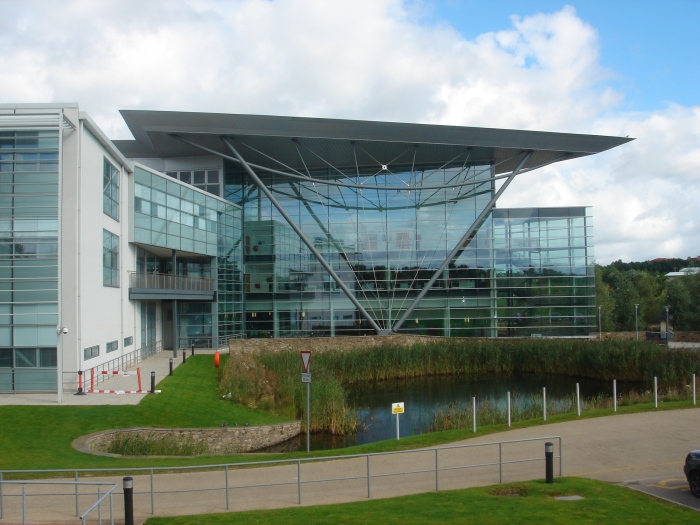I’ve just had a very enjoyable visit to the UKMO Hadley Centre, courtesy of Richard Betts. My talk was similar to the one I recently gave in Japan, which had been a bit clunky and unrehearsed in parts, so in the intervening weeks I revised it a bit which I think/hope made it a bit more coherent. Some of it was old stuff about single model vs multi-model ensembles (including work done ages ago in collaboration with UKMO people, in fact), and some was on model evaluation via paleoclimate simulations. I’ll not put the slides up online yet as this includes some unpublished work that I’m just a minor author on and which is under revision as I type. The last, still relatively unpolished, part of the talk concerned the thorny topic of model independence. I think I’ve now finally reached the point at which I’ve got enough material to write a paper on this. I’ve not usually worked this way round, but it seems that forcing oneself to put down thoughts sufficient to support a presentation can be a helpful way to kickstart the writing process. I had fun giving the talk, and judging from the questions after, many of the impressively large audience stayed awake.
We rounded things off with a lovely pub lunch with Richard, @dougmcneall and one other who despite our encouragement is still shying away from social media :-) The Virgin Cross-country train (direct from Leeds) is not the most comfortable way to travel ("airline" seats seems a bit of poetic license), but it did get the job done. The grim north is not so remote after all! Now we’ve got a month at home to do some work, before the next set of trips kicks off. |
Friday, February 27, 2015
BlueSkiesResearch.org.uk: Blue skies at the UKMO Hadley Centre
Labels:
blueskiesresearch,
climate science
Saturday, February 21, 2015
[jules' pics] The pitter patter of tiny feet
Well.. it's more like... things that go bump in the night
--
Posted By Blogger to jules' pics at 2/21/2015 04:45:00 PM
This is Riley, and he's up for adoption. We are fostering him for Bentham Pet Rescue. Apparently it is much better for homeless cats to stay in people's homes than at a cattery. He's been at the rescue since October and it is hard to imagine why he hasn't found a home as he is as big and furry a cat as you could hope for. He also plays games, demands to be stroked by head butting, and purrs whenever you go near him. He talks quite a lot and comes when called, and hasn't even broken any of our belongings yet. Having only been in the house only 24 hours, he still seems a little lost, wondering what is going to happen next. We are at home for quite a bit of the day, so we are hoping he will adjust to being a bit less nocturnal.
--
Posted By Blogger to jules' pics at 2/21/2015 04:45:00 PM
Tuesday, February 17, 2015
One for the penguin lovers
I'm not sure if either of my readers is interested in spending a(nother!) season in a primitive hut with only penguins for company (slight exaggeration, reports indicate it's more Shinjuku station than Scott of the Antarctic), but if not you can always play “guess the relative” with the photos in the job advert instead :-)
Labels:
random
Monday, February 16, 2015
BlueSkiesResearch.org.uk: From the sublime to the ridiculous…and back again
Just had two weeks in Japan, mostly visiting our friends and colleagues in AORI and NIES. These institutes are both some way outside Tokyo but on the same train line out of Tokyo, so we stayed in Asakusa, close by the famous Senso-ji temple  Not ignoring Hinode, which strange as it may seem, is also well within Tokyo’s boundaries! Not ignoring Hinode, which strange as it may seem, is also well within Tokyo’s boundaries!AORI always seems a bit of strange and desolate place, part of a large research campus of Tokyo University, which was basically built in the middle of nowhere a decade ago but around which shops and services are gradually expanding. It still seems very empty though.  The scientific content of the trip was mostly focussed around paleoclimate stuff, particularly how the strength and stability of the North Atlantic component of the overturning circulation might have changed in past glacial cycles. We were working on this previously with a postdoc who transferred to AORI (along with her funding) when we left. Hopefully there will be more to say on these topics in the future, as papers are written. The visit to NIES was more of an exchange of updates, I gave a seminar and then the group we had collaborated with all summarised their latest work. Rather like the old JUMP meetings we used to have, in fact (that website never really came to much, as we were pretty much on the way out when we set it up). The scientific content of the trip was mostly focussed around paleoclimate stuff, particularly how the strength and stability of the North Atlantic component of the overturning circulation might have changed in past glacial cycles. We were working on this previously with a postdoc who transferred to AORI (along with her funding) when we left. Hopefully there will be more to say on these topics in the future, as papers are written. The visit to NIES was more of an exchange of updates, I gave a seminar and then the group we had collaborated with all summarised their latest work. Rather like the old JUMP meetings we used to have, in fact (that website never really came to much, as we were pretty much on the way out when we set it up).
It was a bit of a culture shock, setting off from here where most of our neighbours are sheep and highland cattle in open fields, and arriving less than 24 later in central Tokyo where the sheeple are battery-farmed in a rather more intensive manner. However we are still probably more accustomed to life in Japan than the UK these days, so once we’d learnt the local train stations and lines (of which there are no fewer than four, most of which we hadn’t used much) it was plain sailing, and actually quite relaxing to be able to play the part of a short-term visitor rather than struggling to fit in as residents. We very much enjoyed the visit and hope to go back for more but didn’t think for a minute that we had made the wrong decision in leaving.
|
Labels:
blueskiesresearch,
climate science,
japan
Thursday, February 12, 2015
That Marotzke/Forster vs Lewis thing
I dunno, spend a couple of weeks out of the country and a proper debate strikes up for a change. Marotzke and Forster published this paper basically arguing that the AR5 models don't generally either over- or underestimate temperature changes, based on various trends within the last century or so (up to now). My first thought on a superficial glance at the paper was that it wasn't really that useful an analysis, as we already know that the models provide a decent hindcast of 20th century temps, so it's hardly surprising that looking at shorter trends will show the models agreeing on average over shorter trends too (since the full time series is merely the sum of shorter pieces). That leaves unasked the important question of how much the models have been tuned to reproduce the 20th century trend, and whether the recent divergence is the early signs of a problem or not. (Note that on the question of tuning, this is not even something that all modellers would have to be aware of, so honestly saying "we didn't do that" does not answer the question. But I digress.)
One limitation of the MF study was that they do not know the forcing for each model, or the α and κ parameters, so had to estimate them by linear regression based on (among other things) their temperature time series. Along comes Nic Lewis, and says "aha - this is circular". Now I haven't had time to look into it in detail, but this argument clearly has some validity in principle. MF replied here, but I'm not really impressed by what they said. There is a certain amount of talking past each other - MF are saying that their method is physically reasonable (which it is) and, in previous work, gives good results, however they don't really address the main criticism. Lewis says their method is simply invalid, because the assumptions underlying the statistical theory are violated. In that respect, it is worth pointing out that probably just about all statistical analysis is simply invalid at some level, since the assumptions are rarely precisely correct. Exact linearity, independent errors, gaussian statistics? You've got to be joking. These are never more than approximations to the truth, but hopefully the approximations are good enough that the end result is useful.
Some of the commenters on the climate lab book thread seem to have got a good handle on it. Just to expand on it a bit, if MF got the "correct" values for forcing, α and κ then it wouldn't matter where these numbers came from. However, there will be some uncertainty/inaccuracy in the estimates they have derived, and these did come from the temperature time series, and will lead to some circularity. So the question is really whether these inacuracies are big enough to matter. I have an idea for investigating the magnitude of the problem (which a priori could either be negligible or could indeed invalidate the work). I'm not sure it's really worth the effort though.
Labels:
climate science,
climate sensitivity,
statistics
The importance of priors!
I was amused to see the different publicity, and reaction, to two pieces of research recently. The first was that silly article about running, which claimed that too much running is bad for you. Interestingly, that BBC page seems to have changed from the tautologous "too much" to the term "running hard", which if anything makes it worse, becaue too much being bad is just a definition of what too much means, whereas running hard...well that's where the research falls down. It only took a couple of mins to find the relevant paper, which shows...huge error bars on estimated risk for hard runners, such that the confidence interval on the hazard ratio actually goes below 1 (at which point running hard is good for you!). The underlying problem is that study was small, there were only 36(?) runners in this group, and this simply isn't enough to show conclusively what the health effects would be. I believe that More or Less has dealt with this, though I haven't listened to it yet.
Then just yesterday, David Spiegelhalter drew my attention to a study on the effects of alcohol, which claimed that modest drinking had no benefits (in opposition to the widely held view that it did). He explains that the study was again underpowered, such that any modest effect would by construction not be "statistically significant". The underlying problem is that, as Andrew Gelman often mentions, where an effect is probably small (but non-zero) and only weak studies with small samples are used, any "significant" result will necessarily be a huge overestimate of the effect (ie, if the true value is x but the error bar is ±10x then only estimates that come out to as much larger than x, and perhaps even with the wrong sign, can be reported as significant), and any realistic estimate close to the true value of x will be found "insignificant" and therefore be liable to being discarded or denied by silly scientists.
One obvious solution is to use a Bayesian approach with a reasonable prior, which in both cases would have found that the new data were insufficient to overturn what was previously believed to be the case...but that won't publish high profile papers or sell newspapers.
Labels:
hype,
media,
probability,
statistics
Wednesday, February 04, 2015
Sunday, February 01, 2015
The death of dialogue
So it is reported, anyway. No sign of anything official on the CD site, but the post by Crok seems to confirm it according to google translate. It is hardly a surprise, it was hardly a roaring success from the outset and the "dialogue" that I participated in was a turgid affair where the participants were repeatedly urged to add more comments long after it had become abundantly clear to all that no-one else was reading.
Labels:
blogging,
climate science
Subscribe to:
Comments (Atom)





